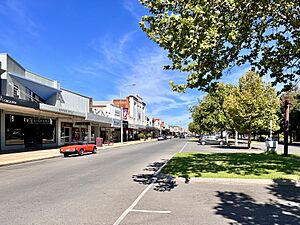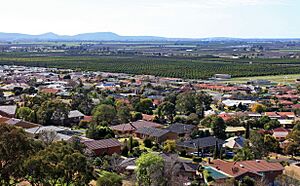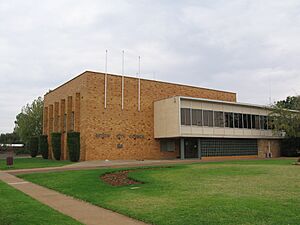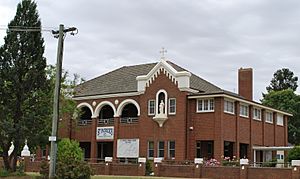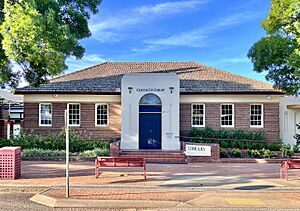Griffith, New South Wales facts for kids
Quick facts for kids GriffithNew South Wales |
|||||||||
|---|---|---|---|---|---|---|---|---|---|
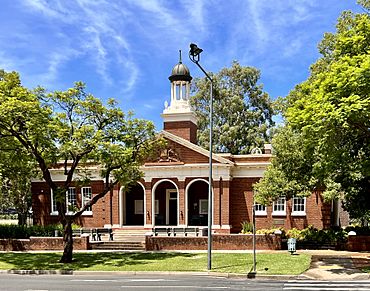
Griffith Court House
|
|||||||||
| Population | 20,569 (2021) | ||||||||
| Established | 4 August 1916 | ||||||||
| Postcode(s) | 2680 | ||||||||
| Elevation | 129.2 m (424 ft) | ||||||||
| Time zone | AEST (UTC+10) | ||||||||
| • Summer (DST) | AEDT (UTC+11) | ||||||||
| Location |
|
||||||||
| LGA(s) | City of Griffith | ||||||||
| County | Cooper | ||||||||
| State electorate(s) | Murray | ||||||||
| Federal Division(s) | Farrer | ||||||||
|
|||||||||
Griffith is an important city in the north-western Riverina region of New South Wales. It's often called the "food bowl of Australia" because of its rich farming. Griffith is also where the local government for the City of Griffith is based.
Like Australia's capital, Canberra, Griffith was planned by famous architects Walter Burley Griffin and Marion Mahony Griffin. The city was named after Arthur Hill Griffith, who was in charge of public works in New South Wales at the time. Griffith became a city in 1987. In 2021, about 20,569 people lived there.
You can reach Griffith by road from Sydney and Canberra using the Hume Highway and the Burley Griffin Way. From Melbourne, you can take the Newell Highway and then the Kidman Way or the Irrigation Way. Other roads connect Griffith to places like Adelaide, Orange, and Bathurst.
Contents
History of Griffith
Griffith was started in 1916. It was part of a big project by the New South Wales government. This project, called the Murrumbidgee Irrigation Area (MIA), aimed to bring water from the Murrumbidgee River to farms in western New South Wales.
The main dam for this project was the Burrinjuck Dam, located between Gundagai and Canberra. This dam stored water that was then released down the river for irrigation. A weir (a low dam) called Berembed Weir was built across the Murrumbidgee River. From there, a large canal, almost like a river itself, flows through the MIA to Griffith. This canal supplies water to the whole area, ending in rice farms northwest of the city.
The water supply got even better when the Australian government built the Snowy River scheme in the 1950s and 1960s. The Blowering Dam, a huge dam near Tumut, stores a lot of water. This water is released down the Murrumbidgee River for farming around Leeton, Griffith, and the newer Coleambally area.
From the very beginning of the MIA, farmers in Griffith grew lots of citrus fruits, other fruits, and vegetables. In the 1950s, the farming area grew to include large rice farms. Vineyards (places where grapes are grown for wine) were also started early on. Wineries soon followed, with McWilliam's Wines at Hanwood and Yenda, two villages near the city.
Italian Influence in Griffith
From its early days, many Italian workers came to the MIA. Some first worked for Australian farmers on steamboats along the Murrumbidgee and Murray Rivers. Today, about 60% of Griffith's population has Italian family roots. These include the first Italian settlers and others who came to Australia during the Great Depression. A second wave of Italian immigrants arrived in Griffith in the late 1950s and early 1960s.
Griffith is known for its great wine and food. This is largely thanks to its diverse population, especially the contributions from Italian-Australians. Griffith's population is now becoming even more diverse, with a growing Sikh Indian community. Griffith is a sister city with Treviso, an Italian city in the Veneto Region. Many Italians in Griffith come from the Veneto or Calabria regions of Italy.
The Italian influence helped expand the types of fruits and vegetables grown. It also greatly increased the number of wineries and the variety of wines made in the region. Wineries like De Bortoli Wines and Rosetto were started by Italian immigrants. Today, they are famous across Australia. More recently, Yellow Tail, one of the country's best-known wine brands, is produced by Casella Family Brands in Griffith. Casella, DeBortoli, McWilliam's, Warburn, and Berton Vineyards are now among Australia's top 20 wine producers.
Griffith is home to the cathedral for the Anglican Diocese of Riverina. The church, named St Alban the Martyr, had its foundation stone laid in 1954. It became a cathedral in 1984.
Until February 2010, Griffith did not have any traffic lights. The first set was installed at the intersection of Burrell Place and Wakaden Street.
Heritage Sites
Griffith has some special heritage-listed places, including:
- Scenic Drive: Hermit's Cave
Climate in Griffith
Griffith has a semi-arid climate. This means it has hot summers and cool winters. The highest temperature ever recorded was 46.0 degrees Celsius on January 23, 2001. The lowest was -6.0 degrees Celsius on July 17, 1977.
| Climate data for Griffith | |||||||||||||
|---|---|---|---|---|---|---|---|---|---|---|---|---|---|
| Month | Jan | Feb | Mar | Apr | May | Jun | Jul | Aug | Sep | Oct | Nov | Dec | Year |
| Record high °C (°F) | 46.0 (114.8) |
45.2 (113.4) |
40.2 (104.4) |
36.1 (97.0) |
28.6 (83.5) |
25.0 (77.0) |
23.0 (73.4) |
30.0 (86.0) |
35.0 (95.0) |
38.3 (100.9) |
43.0 (109.4) |
44.0 (111.2) |
46.0 (114.8) |
| Mean daily maximum °C (°F) | 32.8 (91.0) |
32.1 (89.8) |
28.8 (83.8) |
24.0 (75.2) |
19.3 (66.7) |
15.5 (59.9) |
14.4 (57.9) |
16.5 (61.7) |
19.8 (67.6) |
23.8 (74.8) |
28.0 (82.4) |
30.8 (87.4) |
23.8 (74.8) |
| Mean daily minimum °C (°F) | 16.9 (62.4) |
17.3 (63.1) |
14.2 (57.6) |
10.2 (50.4) |
7.2 (45.0) |
4.5 (40.1) |
3.5 (38.3) |
3.9 (39.0) |
5.8 (42.4) |
8.9 (48.0) |
12.5 (54.5) |
15.1 (59.2) |
10.0 (50.0) |
| Record low °C (°F) | 6.8 (44.2) |
7.6 (45.7) |
4.2 (39.6) |
0.0 (32.0) |
−2.0 (28.4) |
−4.0 (24.8) |
−5.9 (21.4) |
−3.3 (26.1) |
−2.0 (28.4) |
0.6 (33.1) |
1.8 (35.2) |
4.2 (39.6) |
−5.9 (21.4) |
| Average precipitation mm (inches) | 33.2 (1.31) |
26.5 (1.04) |
32.9 (1.30) |
27.8 (1.09) |
35.7 (1.41) |
34.1 (1.34) |
33.5 (1.32) |
35.9 (1.41) |
33.2 (1.31) |
39.2 (1.54) |
32.4 (1.28) |
32.7 (1.29) |
397.3 (15.64) |
| Average precipitation days | 4.2 | 3.7 | 3.9 | 4.6 | 6.4 | 7.6 | 9.4 | 9.0 | 7.5 | 6.4 | 5.3 | 4.9 | 72.9 |
| Average relative humidity (%) | 28 | 34 | 37 | 41 | 53 | 63 | 62 | 54 | 47 | 37 | 35 | 31 | 43 |
Economy and Industry
Griffith is the main service center for the huge Murrumbidgee Irrigation Area. This area is one of the most productive farming regions in Australia. Because of its irrigation, Griffith is very rich in agriculture. It is known as Australia's "Wine and Food Country."
Shopping and Business
Griffith has seen a lot of business growth recently. The main shopping streets are Banna Avenue and Yambil Street. There are also several shopping centers, including:
- Griffith City Plaza
- Griffin Plaza
- Griffith Central
- Griffith Lifestyle Centre
- The Gateway Centre
- Griffith Woolworths Complex
- Driver Shopping Complex
Local Industries
Griffith is home to the Riverina's biggest employer, the Baiada Group, which processes poultry. Griffith also has many wineries, such as De Bortoli Wines and Casella Family Brands. Casella Family Brands makes the popular Yellow Tail wine.
Residential Areas
Besides the city of Griffith itself, the area includes smaller towns and villages. These are Willbriggie, Hanwood, Beelbangera, Bilbul, Yoogali, Widgelli, Yenda, Lake Wyangan, Tharbogang, and Warburn. Within the city, there are suburbs like Collina, Driver, North Griffith, East Griffith, West Griffith, South Griffith, Murrumbidgee, Mayfair, Pioneer Mooreville, and Wickhams Hill. The newest suburb, Collina, is located northeast of the city center.
Population and Demographics
In the 2021 Census, Griffith had 20,569 people.
- About 5.8% of the population were Aboriginal and Torres Strait Islander people.
- The most common backgrounds were Australian (26.7%), English (25.7%), Italian (22.4%), Irish (7.0%), and Indian (6.4%).
- 66.8% of people were born in Australia. Other common birthplaces included India (8.8%), Italy (3.4%), Philippines (1.8%), New Zealand (1.8%), and Malaysia (1.2%).
- 65.8% of people spoke only English at home. Other languages spoken included Italian (5.2%), Gujarati (4.6%), Punjabi (4.4%), Samoan (1.5%), and Mandarin (1.2%).
- The most common religions were Catholic (34.9%), No Religion (18.0%), and Anglican (10.4%).
The forecast for Griffith's population in 2023 was 27,666. It is expected to grow to 30,494 by 2036.
Education in Griffith
Griffith is the third largest education center in the Riverina, after Wagga Wagga and Leeton.
Griffith has three high schools:
- Murrumbidgee Regional High School – This school has two campuses, which used to be Wade High School and Griffith High School.
- Marian Catholic College (formerly Catholic High School)
- Verity Christian College - started in 2021
There are also 13 primary schools and many day care and pre-school facilities. Griffith has one of the largest campuses of Riverina Institute of TAFE, which offers vocational training.
Transportation in Griffith
Griffith is an important meeting point for the Kidman Way, Burley Griffin Way, and Irrigation Way roads. It is about 550 kilometers southwest of Sydney and 450 kilometers north of Melbourne. Griffith has daily bus services to major cities.
Griffith Airport has daily flights to Sydney (by Rex Airlines) and to Melbourne (by Sharp Airlines) since July 15, 2019. There are also regular flights to Broken Hill and Narrandera.
Griffith Buslines operates buses throughout Griffith and nearby towns. There are seven main bus routes.
The railway arrived in Griffith on July 3, 1916. Since then, it has transported passengers and goods. Regular goods trains still run, making it a unique railway center.
Griffith railway station has a NSW TrainLink Xplorer train service from Sydney twice a week. NSW TrainLink also runs several coach (bus) services. These coaches connect to Sydney-Melbourne XPT trains at either Wagga Wagga or Cootamundra.
- 05:38 AM: From Wagga Wagga to Griffith (Saturday & Monday mornings)
- 09:20 AM: From Griffith to Wagga Wagga (daily)
- 09:36 AM: From Mildura to Cootamundra (daily)
- 04:53 PM: From Wagga Wagga to Griffith (daily)
- 05:31 PM: From Cootamundra to Mildura (daily)
- 08:55 PM: From Griffith to Wagga Wagga (Friday & Sunday nights)
V/Line runs a daily bus service between Melbourne and Griffith. You change from the train to the bus at Shepparton. The trip from Melbourne to Griffith is an evening service daily. The Griffith to Melbourne service runs overnight from Monday to Saturday and in the afternoon on Sunday. The journey takes about six and a half to seven hours.
In February 2010, the city's first traffic lights were installed. They are at the intersection of Burrell Place and Wakaden Street to help with traffic in Griffith's city center.
Events and Festivals
Griffith hosts many exciting events throughout the year:
- Riverina Field Days: Held every May, showcasing farming and rural life.
- La Festa, Wine, Food and Multicultural Festival: Celebrated every Easter weekend.
- Festival of Gardens: Held annually in October, featuring beautiful gardens.
- Sikh Games: Held every June Long Weekend, a big sports event.
- unWINEd: Also held every June Long Weekend, focusing on wine and relaxation.
- Multicultural Festival of Griffith: Takes place every October, celebrating the city's diverse cultures.
- Festa delle Salsicce (Festival of the Sausage): Held every August, a fun food festival.
Media and News
Radio Stations
Griffith has many radio stations, including commercial, community, and national stations like SBS and ABC.
Local stations broadcasting from Griffith include ABC Riverina. There's also the AM radio commercial station Triple M Riverina MIA and the FM radio commercial station Hit FM. Both are owned by Southern Cross Austereo. You can also hear a rebroadcast from Sky Sports Radio. Other local stations include the Christian radio station Vision Radio Network and the community station 2MIAFM95.1. The ABC's national stations like Radio National, ABC Classic FM, ABC NewsRadio, and Triple J, plus the multicultural network SBS Radio, are also broadcast in Griffith.
ABC Riverina is the local ABC station for the whole MIA region. It broadcasts local breakfast and morning shows from Wagga Wagga studios on weekdays. On Wednesdays and Saturdays, the local morning show is also shared with other ABC Local Radio stations. This lets listeners from outside the area call into the popular gardening show. ABC Riverina also has local news, produced by local journalists. They also have rural reports and a local Saturday breakfast show, followed by a local sports program.
Triple M Riverina MIA 963 is a commercial FM station based in Griffith. It broadcasts from Griffith studios during the day and then plays programs from other networks like 2GB and Triple M. This station also creates local news bulletins for itself and its sister station, 99.7 Star FM.
Hit FM, also owned by Southern Cross Austereo, is a commercial FM station for younger listeners. It plays Top 40 and pop music. After its local breakfast show, it plays music from the Hit Music Network.
2MIA is a local community station. It broadcasts local programs presented by radio announcers. This station is aimed at older listeners and plays a lot of music. Most programs are made locally, but some come from the national community radio network.
Television Channels
Griffith has five television stations. Three are commercial stations, all owned by WIN Television's owner WIN Corporation. These are AMN, MTN, and MDN. They are regional partners of Australia's three main commercial TV networks: Ten Network, Nine Network, and Seven Network. There are also public broadcasters: the ABC and SBS.
Before the 1990s, Griffith only received the ABC and MTN. MTN was an independent station that showed programs from all three commercial networks.
Now, the town receives the commercial networks' digital channels. These include 7Two, 7mate, 9Go!, 9Gem, 9Life, 10 Bold, and 10 Peach (all from WIN Television). You can also watch TVSN, Gold, Sky News Regional, ABC TV Plus/ABC Kids, ABC Me, ABC News, SBS Viceland, SBS Food, SBS WorldWatch, and NITV. Foxtel offers paid satellite television services.
MTN shows programs from Seven Network. AMN shows programs from Nine Network. MDN shows programs from Ten Network. WIN also broadcasts the Riverina and MIA WIN News bulletin every weekday evening.
Local news for Griffith and the MIA area is provided on all three commercial networks. WIN Griffith airs short 90-second local news updates during the day. WIN News bulletins are put together in newsrooms in the city but are presented from studios in Wollongong.
Newspapers
The Area News is a local newspaper published in Griffith every Monday, Wednesday, and Friday. You can also buy national newspapers like The Sydney Morning Herald, The Australian, The Daily Telegraph, Herald Sun, The Weekly Times, and The Age.
Sports in Griffith
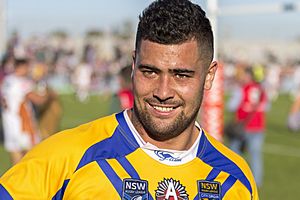
The most popular sport in Griffith is Rugby League. Griffith has two clubs in the Group 20 Rugby League competition: the Griffith Black & White Panthers and the Griffith Waratah Tigers. These two clubs are among the most successful in the league. The Panthers have won 6 titles, and the Tigers have won 13. A local derby (a game between the two teams) in the 2017 Grand Final drew over 2,000 people. A third club, the Yenda Blueheelers, is based in the small town of Yenda, 15 kilometers from the city center. They also play in this competition and have won 7 titles. Many National Rugby League players come from Griffith, with some even playing for their state and country.
Griffith and District Rugby League teams:
The Griffith and District Football Association (Soccer) has six clubs in the Griffith area. These are Griffith City FC, Hanwood FC, West Griffith SC, Yenda Tigers SC (seniors only), Yoogali FC, and Yoogali SC. Yoogali SC also has teams in the Capital Football competition. Hanwood FC has senior men's and women's teams in the Wagga competition.
The Griffith District Cricket Association (GDCA) runs a cricket league during the summer. It has four grades and six teams. Games are played in Twenty20, One Day, and Two Day formats. Five of the six clubs (Coro Cougars, Exies Diggers, Exies Eagles, Leagues Panthers, and Hanwood Wanderers) are based in Griffith. The Coly Nomads are from nearby Coleambally.
Griffith also has an Australian rules football team, the Griffith Swans. They play in the Riverina Football League. They have won three titles: in 1952, 1968, and 2003. They used to play in the South West League. Griffith also has a rugby union team, the Griffith Blacks. They play in the Southern Inland Rugby Union. The city also has strong local hockey and basketball competitions.
Tourist Attractions
Griffith has many places to visit. These include Pioneer Park, a Regional Theatre with 510 seats, the Italian museum, the Griffith Regional Art Gallery, and shops selling crafts and antiques. The city is also known for its many high-quality restaurants. Many of Griffith's wineries offer wine tasting at their cellar doors. Some notable ones are De Bortoli Wines, Beelgara Estate (formerly Rossetto Wines), West End Wines, Berton Vineyards, and Warburn Estate. Griffith is famous for its botrytis wines, like De Bortoli's Noble One, and its fortified wines, such as McWilliam's Hanwood Port.
You can also enjoy ecotourism in Griffith. Scenic Hill has various walking trails and lookouts. It is also home to the famous Hermit's Cave. Campbells and Nericon Swamps are important places for migratory birds. Nearby Cocoparra National Park offers walking trails. You can also explore along the Murrumbidgee River and Lake Wyangan.
Twin Towns and Sister Cities
Griffith has special partnerships, called "twin towns" or "sister cities," with:
 Harbin, China
Harbin, China Comunita Montana del Grappa, Italy
Comunita Montana del Grappa, Italy Fairfield, New South Wales, Australia
Fairfield, New South Wales, Australia
Notable People from Griffith
Many well-known people come from Griffith:
- Simon Bonetti: An Australian rugby league player who won a championship in 2002.
- Ray Brown: An Australian rugby league player from the 1980s.
- Joseph Colpitts: An Australian Infantry Sergeant who fought in WWII. He helped rescue Allied soldiers from Crete. Colpitts Place in Griffith is named after him.
- Andrew Fifita: An Australian rugby league player who scored the winning try in the 2016 NRL Grand Final.
- Geoff Foster: An Australian rugby league player from the 1970s and 1980s.
- Evonne Goolagong: A World No. 1 Australian female tennis player.
- Stan Grant: A TV and radio presenter, journalist, writer, and lecturer.
- Fred Griffiths: A South African rugby league player from the 1950s and 1960s. He coached the Griffith Black & Whites.
- Michael Henderson: An Australian rugby league player from the 2000s and 2010s.
- Gary Higgins: Former opposition leader of the Northern Territory Parliament.
- Greg Keenan: An Australian rugby league player from the 1990s.
- Mark Larkham: A racing car driver.
- Trevor Long: A technology commentator and TV expert. He was born in Griffith.
- David Milne: An Australian rugby league player from the 2000s and 2010s.
- Laurie Moraschi: An Australian rugby league player from the 1960s and 1970s.
- Phillip Noyce: A director known for films like Rabbit-Proof Fence (2002) and Salt (2010).
- Luke O'Dwyer: An Australian rugby league player from the 2000s and 2010s.
- John O'Neill: An Australian rugby league player from the 1960s and 1970s.
- Esava Ratugolea: An Australian rules footballer.
- Harry Rowston: An Australian rules footballer.
- Valerio Ricetti: A famous cave-dwelling hermit.
- Robbie Simpson: An Australian rugby league player from the 1990s and 2000s.
- Shaun Spence: An Australian rugby league player from the 2010s.
- Gary Warburton: An Australian rugby league player from the 2000s and 2010s, born in Griffith.
- Jason Wells: An Australian rugby league player from the 2000s.
|



